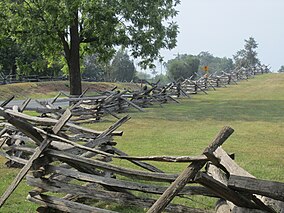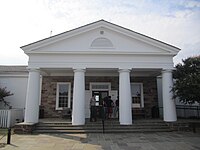| This article includes a list of general references, but it lacks sufficient corresponding inline citations. Please help to improve this article by introducing more precise citations. (August 2024) (Learn how and when to remove this message) |
| Manassas National Battlefield Park | |
|---|---|
 Period fence at Manassas Battlefield Period fence at Manassas Battlefield | |
  | |
| Location | Prince William County, Virginia, U.S. |
| Nearest city | Gainesville, Virginia. U.S. |
| Coordinates | 38°48′46″N 77°31′18″W / 38.81278°N 77.52167°W / 38.81278; -77.52167 |
| Area | 5,073 acres (20.53 km) |
| Established | November 14, 1936 |
| Visitors | 715,622 (in 2005) |
| Governing body | National Park Service |
| Website | Manassas National Battlefield Park |
| Manassas National Battlefield Park | |
| U.S. National Register of Historic Places | |
| U.S. Historic district | |
| U.S. National Battlefield Park | |
| NRHP reference No. | 66000039 |
| Added to NRHP | October 15, 1966 |
Manassas National Battlefield Park is a unit of the National Park Service located in Prince William County, Virginia, north of Manassas that preserves the site of two major American Civil War battles: the First Battle of Bull Run, also called the Battle of First Manassas, and the Second Battle of Bull Run or Battle of Second Manassas. It was also where Confederate General Thomas J. Jackson acquired his nickname "Stonewall". The park was established in 1936 and listed on the National Register of Historic Places on October 15, 1966.
More than 700,000 people visit the battlefield each year. The Henry Hill Visitor Center, on Sudley Road by the south entrance to the park, offers exhibits and interpretation regarding the First Battle of Bull Run, including Civil War-era uniforms, weapons, field gear and an electronic battle map. The center offers the orientation film Manassas: End of Innocence, as well as a bookstore.
A recent find in 2014 unearthed bone fragments that led to the discovery of the skeletal remains of two Union soldiers in what is now thought to be a Surgeon's Pit. The remains were found among the bones of several other limbs in the pit. Carbon dating shows that the pair died during the Battle of Second Manassas, also known as Second Bull Run, in August 1862. The remains were moved on Tuesday, June 19, 2018, and transferred from the National Park Service to the US Army who will be burying them in Arlington National Cemetery.
Historic sites


- Stone House – used as a hospital during both battles. It is near the intersection of Sudley Road and Lee Highway (Warrenton Turnpike).
- Stone Bridge – which the Union retreated across after Second Bull Run. It crosses just north of Lee Highway (Warrenton Turnpike) at the Fairfax-Prince William Co. line.
- Brawner's Farm – the opening phase of the second battle. The parking lot is off of Pageland Lane at the western edge of the battlefield. It has recently been renovated to become a museum dedicated to the Second Battle of Bull Run.
- Battery Heights – where Confederate batteries were deployed to fire on the attacking Union troops at nearby Brawner's Farm. It is off of Lee Highway (Warrenton Turnpike).
- Matthews Hill – the opening phase of the first battle. It is off of Sudley Road.
- The Unfinished Railroad Grade – where Jackson deployed his men before the second battle after capturing Pope's supply depot. Off of Featherbed Lane.
- The Deep Cut – where Pope launched the bulk of his attacks against the Grade. It is off of Featherbed Lane, before you reach the Railroad Grade.
- Groveton – an extinct Civil War era village. All that remains is the small frame house that Lucinda Dogan lived in. A Confederate Cemetery is nearby. Both are off Lee Highway (Warrenton Turnpike).
- New York Monuments – two monuments dedicated to the 5th and 10th New York Regiments. These mark where the 5th New York Zouaves lost 123 men in 5 minutes in the advance of Hood's men; off of Lee Highway (Warrenton Turnpike), near Young's Branch on 5th New York Avenue and cross from the Confederate cemetery at Groveton.
- Hazel Plain – the plantation of the Chinn family. It now sits in ruins, and only the foundation remains. Directly across from the Henry Hill Visitors Center.
- Chinn Ridge – across from Hazel Plain. General James Longstreet's massive counterattack during the second battle took place here. A trail leads to a boulder for Union Colonel Fletcher Webster, the son of the famous orator Daniel Webster, who was killed leading a failed attempt at repulsing the Confederate Counterattack.
- Portici – the plantation of Francis Lewis, now in ruins. This served as the Confederate Headquarters during the first battle, and minor skirmishes between companies occurred on the surrounding plains.
- Robinson House – now in ruins (lost to arson in 1993), was the home of free black man James Robinson. It is on the Henry Hill Loop Trail, walking only. It is not accessible by car.
- Stonewall Jackson Monument – bronze monument erected on Henry Hill. Commemorates General Thomas J. Jackson and contains the origin of his moniker.
See also
- Manassas Peace Jubilee (1911)
References
- The National Parks: Index 2001–2003. Washington: U.S. Department of the Interior.
- Survey No. HABS VA-144. Historic American Buildings Survey.
Notes
- "Listing of acreage – December 31, 2020" (XLSX). Land Resource Division, National Park Service. Retrieved 2021-08-15. (National Park Service Acreage Reports)
- "Park Anniversaries". Retrieved 13 August 2021.
- "National Register Information System". National Register of Historic Places. National Park Service. March 13, 2009.
External links
 Media related to Manassas National Battlefield Park at Wikimedia Commons
Media related to Manassas National Battlefield Park at Wikimedia Commons- National Park Service: Manassas National Battlefield Park
- First Battle of Manassas: An End to Innocence, a National Park Service Teaching with Historic Places (TwHP) lesson plan
- Manassas Battlefield burial pit discovered
- Manassas National Battlefield Park
- Battlefields of the Eastern Theater of the American Civil War
- Parks in Virginia
- National battlefields and military parks of the United States
- Prince William County, Virginia, in the American Civil War
- National Register of Historic Places in Prince William County, Virginia
- National Park Service areas in Virginia
- Museums in Prince William County, Virginia
- Protected areas established in 1940
- American Civil War museums in Virginia
- Parks in Prince William County, Virginia
- Journey Through Hallowed Ground National Heritage Area
- National Register of Historic Places in Fairfax County, Virginia
- Historic districts on the National Register of Historic Places in Virginia
- Conflict sites on the National Register of Historic Places in Virginia
- American Civil War on the National Register of Historic Places
- Parks on the National Register of Historic Places in Virginia

